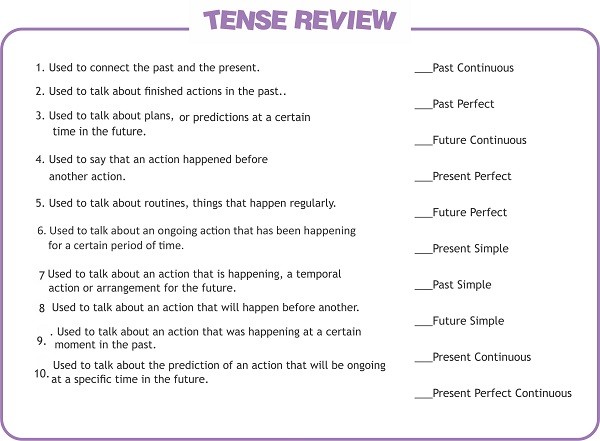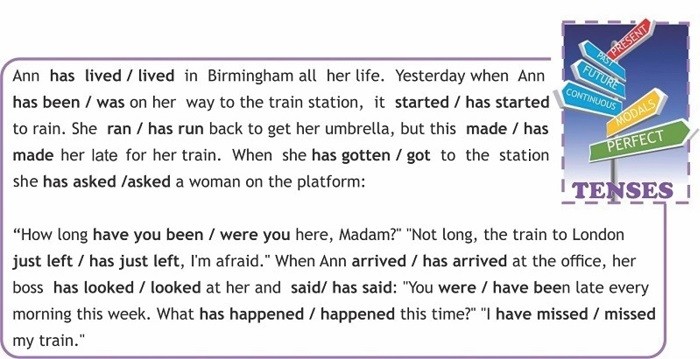- Recent
WHAT WILL WE LEARN?
- Welcome to TENSE REVIEW
- Tense Review Poster
- Simple and Continuous Tense Flashcards
- Multiple Choice
- Choose the word
- What is the tense?
- Read & answer
- WELCOME TO TENSE REVIEW- with perfect tenses
- Tense Review Video
- Perfect Tenses Review
- Perfect Tenses Flashcards
- Guess the sentence
- TENSE REVIEW
- Write the tense
- Practice
Welcome to TENSE REVIEW!
PRESENTE SIMPLE:
Se utiliza para hablar de acciones habituales, rutinas, que tienen lugar con cierta frecuencia, sin hacer referencia a si en el momento actual se están realizando.
| I study English. | Yo estudio inglés; empecé hace algún tiempo y continúo, aunque puede que en el momento presente no esté realizando esta actividad. |
| He plays tennis. | El juega al tenis; practica este deporte con cierta asiduidad, pero no significa que en el momento presente esté en la pista de tenis jugando. |
| I work in a bank. | Yo trabajo en un banco; ésta es mi profesión, aunque puede que en el momento actual yo esté de vacaciones, descansando en mi casa. |
Otra forma de usar el presente simple en acciones futuras es con expresiones de tiempo.
| I leave Madrid tomorrow morning. | Me voy de Madrid mañana por la mañana |
La forma del "present simple" coincide con la del infinitivo sin la partícula "to", salvo en la 3ª persona del singular en la que se le añade una "s".
| Infinitivo | I / you / we / they | He / she / it |
| To eat (comer) | eat | eats |
| To run (correr) | run | runs |
Si el verbo termina en "ss", "sh", "ch", "x", "o", al formar la 3º persona del singular se le añade "-es".
| Infinitivo | I / you / we / they | He / she / it |
| To kiss (besar) | I kiss | He kisses |
| To watch (observar) | I watch | He watches |
Si el verbo termina en "y" tras consonante, al formar la 3ª persona del singular se sustituye esta "y" por una "i", seguida de la terminación "es".
| Infinitivo | I / you / we / they | He / she / it |
| To carry (llevar) | I carry | He carries |
| To envy (envidiar) | I envy | He envies |
Las oraciones negativas se forman con el auxiliar "to do", habitualmente en sus formas contraídas: "don´t" (= do not) para las personas "I, you, we, they", y "doesn´t" (= does not) para las personas "he, she, it".
| I don't play tennis. | Yo no juego al tenis |
| She doesn't go to the cinema. | Ella no va al cine |
| We don't know the answer. | Nosotros no sabemos la respuesta |
La forma interrogativa se forma también con el auxiliar "to do" al comienzo de la oración ("do" con las personas "I, you, we, they"; "does" con "he, she, it").
| Do you play tennis? | ¿Juegas al tenis? |
| Does she go to the cinema? | ¿Va ella al cine? |
| Do we know the answer? | ¿Conocemos la respuesta? |
PASADO SIMPLE:
Se utiliza para referirse a acciones que se desarrollaron en el pasado y que hace ya algún tiempo que finalizaron. Su equivalente en castellano es el pretérito indefinido:
| I studied English. | Yo estudié inglés (fue una actividad que realicé en el pasado y que ya finalizó) |
| I bought a car. | Yo compré un coche |
En estas oraciones no se da información sobre el presente:
| I lost my job. | Yo perdí mi trabajo (puede que en la actualidad lo haya vuelto a recuperar) |
| I bought a car. | Yo compré un coche (en la actualidad puede que ya no tenga el coche, que lo haya vendido) |
Con frecuencia se indica el periodo de tiempo en el que se desarrolló la acción:
| I played tennis yesterday. | Yo jugué al tenis ayer. |
| I went to Paris last summer. | Yo fui a París el verano pasado |
La estructura de la frase es similar a la del presente, utilizando el verbo principal en su forma pasada.
| She listens to music. | Ella escucha música (presente) |
| She listened to music. | Ella escuchó música (pasado) |
En las formas negativas e interrogativas se emplea, asimismo, una estructura similar: se utiliza el verbo auxiliar "to do" en su tiempo pasado, que acompaña al verbo principal en su forma infinitiva:
| I didn´t go to the party. | Yo no fui a la fiesta |
| Did you go to the party? | ¿Fuiste tú a la fiesta? |
En la formación del tiempo pasado hay que distinguir entre verbos regulares e irregulares: los verbos regulares forman el tiempo pasado añadiendo "-ed" a la forma infinitiva, mientras que los irregulares no siguen un patrón determinado, hay que estudiarlos individualmente.
| Verbo regular | "To talk": forma pasada "talked". |
| Verbo irregular | "To drink": forma pasada "drank" |
La forma pasada de los verbos es única para todas las personas, no hay una forma distinta para la 3ª persona del singular como ocurría en el presente.
| I / you / he / she / we / they "listened" |
| I / you / he / she / we / they "went" |
PRESENTE CONTINUO O PROGRESIVO:
Se utiliza para describir acciones que se están desarrollando en este mismo momento:
| I am reading a book. | Yo estoy leyendo un libro (en este preciso instante) |
| You are playing football. | Tú estás jugando al futbol |
También se utiliza para describir acciones que se están desarrollando alrededor del momento en el que se habla, aunque no necesariamente en ese preciso instante:
| I am studying French. | Yo estoy estudiando francés (me he matriculado en una academia, pero no necesariamente en este preciso momento estoy con los libros de francés) |
Otro uso del presente continuo es para describir acciones que se vienen repitiendo con frecuencia o son planes definitivos en el futuro; en este caso, la oración viene acompañada del adverbio "always" (siempre) que puede significar molestía.
| He is always working. | El está siempre trabajando (con el significado de que trabaja frecuentemente, quizás, incluso, excesivamente) |
Formación del "present continuous": se construye con el presente del indicativo del verbo "to be", en su función de verbo auxiliar, y el "present participle" ( = gerundio) del verbo principal.
| Afirmación | Negación | Interrogación |
| I am eating | I'm not eating | Am I eating? |
| You are eating | You aren't eating | Are you eating? |
| He / she is eating | He / she isn't eating | Is he/she eating? |
| We are eating | We aren't eating | Are we eating? |
| You are eating | You aren't eating | Are you eating? |
| They are eating | They aren't eating | Are they eating? |
PASADO CONTINUO O PROGRESIVO
El tiempo pasado progresivo expresa que una acción se estaba desarrollando en un momento del pasado o cuando otra acción ocurrió.
En inglés, al igual que en español, el tiempo pasado progresivo está formado por el verbo auxiliar be conjugado en pretérito más el "present participle" (forma+ing) del verbo principal.
Unos ejemplos son:
| Sujeto | Verbo to be | verbo con ing |
| I | was | talking on the phone. |
| you | were | making lunch. |
| he, she, it | was | eating. |
| they, we | were | working on a project. |
TENER EN CUENTA
Existen dos traducciones en español, se usa el tiempo pasado progresivo para denotar el carácter progresivo de una acción que es interrumpida por otra, o una acción progressiva y un momento en el pasado. El pasado progresivo se usa para denotar el carácter progresivo de una de las acciónes.
| We were watching TV when Claudia called. |
| Nosotros estábamos viendo televisión cuando Claudia llamó. |
| Nosotros veíamos televisión cuando Claudia llamó. |
FUTURO SIMPLE:
El Futuro Simple es un tiempo verbal que se utiliza para describir acciones que se van a desarrollar en el futuro sin necesidad de aclarar en que momento se producirán. Su equivalente en el idioma español es el Futuro Imperfecto. Por ejemplo:
I will study the lesson. Yo estudiaré la lección.
(No se menciona en que tiempo)
He will travel to London. Él viajará a Londres.
(No se especifica cuándo)
They will buy a new car. Ellos comprarán un nuevo auto.
(No se sabe en qué momento)
Aunque también se puede expresar el tiempo en el que se desarrollará la acción, por ejemplo:
Susan will visit her mother tomorrow.
Susan visitará a su madre mañana.
John will travel to New York next month.
John viajará a Nueva York el próximo mes.
Este tiempo verbal utiliza para su construcción el auxiliar WILL seguido del verbo principal en infinitivo. En los siguientes ejemplos veremos la conjugación del Futuro simple en sus formas afirmativa, interrogativa y negativa. (Utilizamos el verbo bailar - TO DANCE - a modo de ejemplo):
También se puede usar en la afirmación la contracción de WILL colocándo 'll al pronombre y en la negación en lugar de WILL NOT se puede utilizar la forma contraída WON'T:
I will play tennis. I'll play tennis.
We will paint the house. We'll paint the house.
She will not buy a house. She won't buy a house.
They will not go to the party. They won't go to the party.
FUTURO CON "GOING TO"
El futuro con «going to» se forma de la siguiente manera:
SUJETO + «BE» (presente simple) + GOING TO + INFINITIVO
Así es…GOING TO va siempre con un verbo en INFINITIVO
Verbos Regulares : Oraciones afirmativas
- I am going to buy – Voy a comprar
- You are going to buy – Vas a comprar
- He / She / It is going to buy – Va a comprar
- We are going to buy – Vamos a comprar
- You are going to buy – Van a comprar
- They are going to buy – Van a comprar
*Ojo aquí: «going to» en inglés se parece mucho a «voy a» en español pero no se usa siempre de la misma manera.
Asimismo, se utiliza para describir una acción que va a tener lugar en el futuro próximo y sobre la que se ha tomado una resolución firme. En este caso, siempre se tiene que mencionar el tiempo en el que se va a desarrollar la acción:
| I am going to London next week. | Yo voy a Londres la próxima semana (la acción se va a desarrollar en el futuro próximo y existe una decisión firme por mi parte de llevarla a cabo) |
FUTURE CONTINUOUS
Se utiliza el "future continuous" para describir una acción que va a tener lugar en el futuro y que en el momento de tiempo al que nos referimos aún seguirá desarrollándose.
WILL: Se forma con will + be + ing: She will be reading her book. Ella estará lleyendo su libro.
GOING TO: Se forma con el going to + be + ing. We are going to be watching the movie. Nosotros vamos a ver la película.
Este momento del futuro puede mencionarse o no en la oración:
|
I will be watching TV. I am going to be watching TV. |
Yo estaré viendo la tele |
|
This evening I will be watching TV. This evening I am going to be watching TV. |
Esta tarde yo estaré viendo la tele |
|
She will be visiting her mother. She is going to be visiting her mother. |
Ella estará visitando a su madre |
La forma negativa se forma interponiendo la negación "not" entre el auxiliar y el verbo principal (atención a su colocación entre los dos componentes del verbo auxiliar: "will" y "be") :
|
I wiIl not be cooking. I am not going to be cooking. |
Yo no estaré cocinando |
|
You will not be dancing. You are not going to be dancing. |
Tú no estarás bailando |
La forma interrogativa se construye comenzando con "will", seguido del sujeto, de la forma infinitiva "be" y del verbo principal:
|
Will you be listening to music? Are you going to be listening music? |
¿Estarás tú oyendo música? |
|
Will we be playing football? Are you going to be playing football? |
¿Estaremos jugando al fútbol? ¿Ustedes estarán jugando fútbol? |
Tense Review Poster
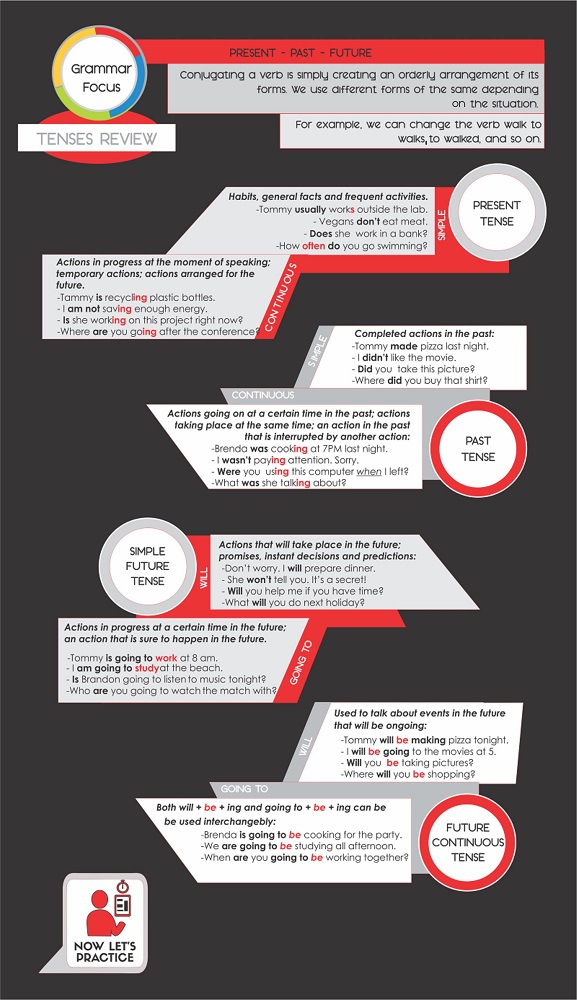
Simple and Continuous Tense Flashcards
CHOOSE THE CONJUGATION FOR THE FOLLOWING SENTENCE:

CHOOSE THE CONJUGATION FOR THE FOLLOWING SENTENCE:

CHOOSE THE CONJUGATION FOR THE FOLLOWING SENTENCE:

CHOOSE THE CONJUGATION FOR THE FOLLOWING SENTENCE:

CHOOSE THE CONJUGATION FOR THE FOLLOWING SENTENCE:

CHOOSE THE CONJUGATION FOR THE FOLLOWING SENTENCE:


Write the conjugation for each verb from the text that is highlighted in RED.

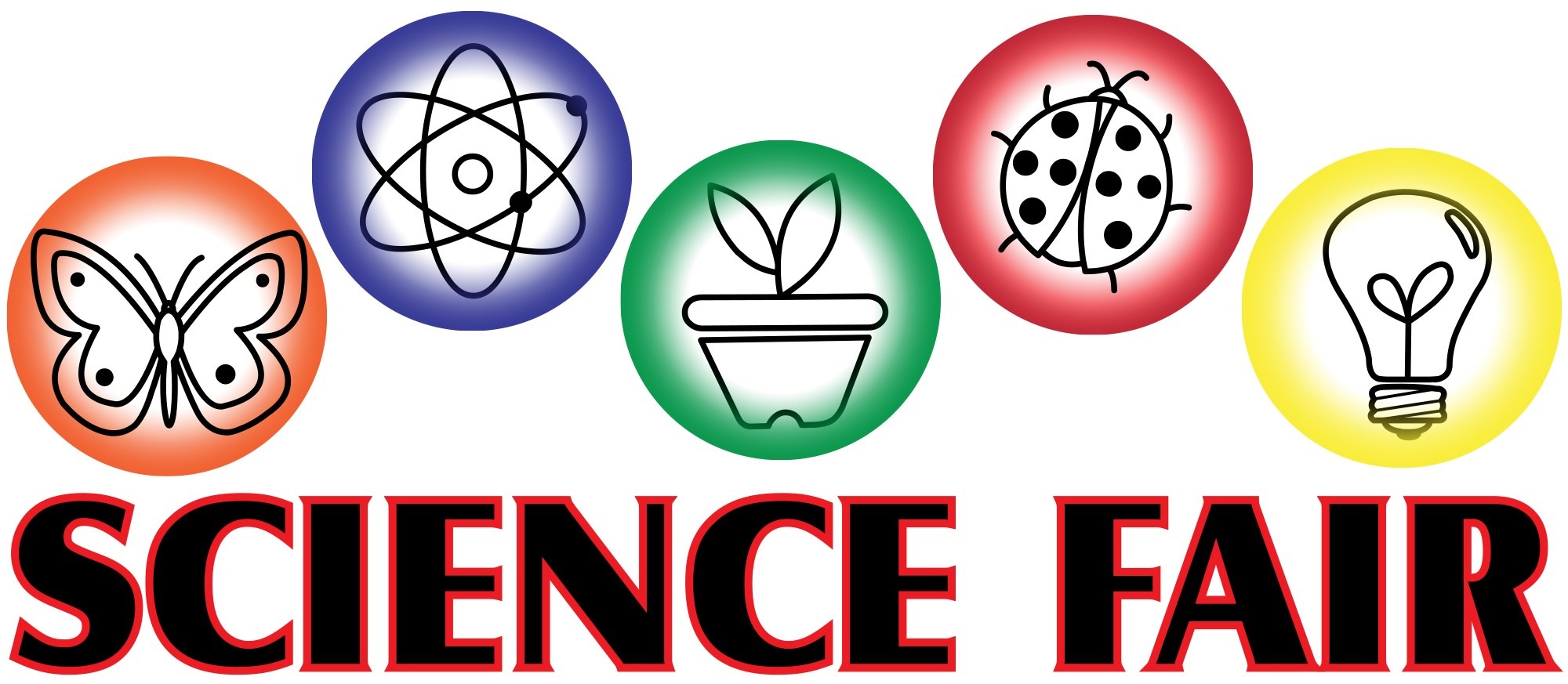
Every year the Science teachers organize a fair. All the students participate by showing new projects that help people take cake of the environment. Last year the topic was "Climate Change" and I wanted to participate in the School's Science Fair. I teamed up with Brandon. We created a system that helps people to manage their waste more efficiently. We won the first place! This year, we are participating again. We are thinking about a new way to reuse energy. We were talking to some friends from England last night. They will send some ideas tomorrow We really want to win again.
WELCOME TO TENSE REVIEW- with perfect tenses
Vamos a repasar los tiempos perfectos que hemos aprendido hasta ahora:
PRESENT PERFECT TENSE
Utilizamos esta conjugación para expresar que una acción que ya sucedio en un tiempo no especificado que es antes del ahora. El momento exacto no es importante, es más importante el resultado de la acción en sí.
| ESTRUCTURA | EJEMPLO |
|
Afirmativa: Sujeto + verbo auxiliar (to have) + participio pasado |
|
|
Negativa: Sujeto + verbo auxiliar (to have) + “not” + participio pasado |
|
|
Interrogativa: Verbo auxiliar (to have) + sujeto + participio pasado…? |
|
PAST PERFECT TENSE
Usamos el pasado perfecto para referirnos a una acción o evento que comenzó en el pasado y que es anterior a otra acción también en el pasado. La acción que ocurrió primero es en pasado perfecto y la que sigue en pasado simple.

| ESTRUCTURA | EJEMPLOS |
|
Afirmativa: Sujeto + "had" + participio pasado |
|
|
Negativa: Sujeto + “had” + “not” + participio pasado |
|
|
Interrogativa: “Had” + sujeto + participio pasado…? |
|
PRESENT PERFECT CONTINUOUS
Usamos el Presente perfecto Continuo para mostrar que algo inició en el pasado y continua ocurriendo hasta el presente.

| ESTRUCTURA | EJEMPLOS |
|
Afirmativa: Sujeto + verbo auxiliar (to have) + “been” + verbo+ing |
|
|
Negativa: Sujeto + verbo auxiliar (to have) + “not” + “been” + verbo+ing |
|
|
Interrogativa: Verbo auxiliar (to have) + sujeto + “been” + verbo+ing? |
|
FUTURE PERFECT TENSE
El Futuro Perfecto es un tiempo verbal que se utiliza para expresar situaciones que se están produciendo o que se desarrollarán en el futuro y que imaginamos que habrán finalizado para cuando llegue el momento al que hacemos referencia.
(123).jpg)
| ESTRUCTURA | EJEMPLOS |
|
Afirmativa: Time expression + Subject + WILL + HAVE + Past participle verb + Complement |
By 9 o'clock she will have prepared dinner. (Para las 9 en punto ella habrá preparado la cena. |
|
Negativa: Time expression + Subject + WILL NOT + Have + Past participle verb + Complement |
By 9 o'clock she wiIl not have prepared the dinner. (Para las 9 en punto, ella no habrá preparado la cena.) |
|
Interrogativa: WILL+ Subject + have + Past participle verb + complement ? Wh word + will + subject + have + Past participle verb + complement ? |
|
Tense Review Video
Perfect Tenses Flashcards
Perfect Tenses Review
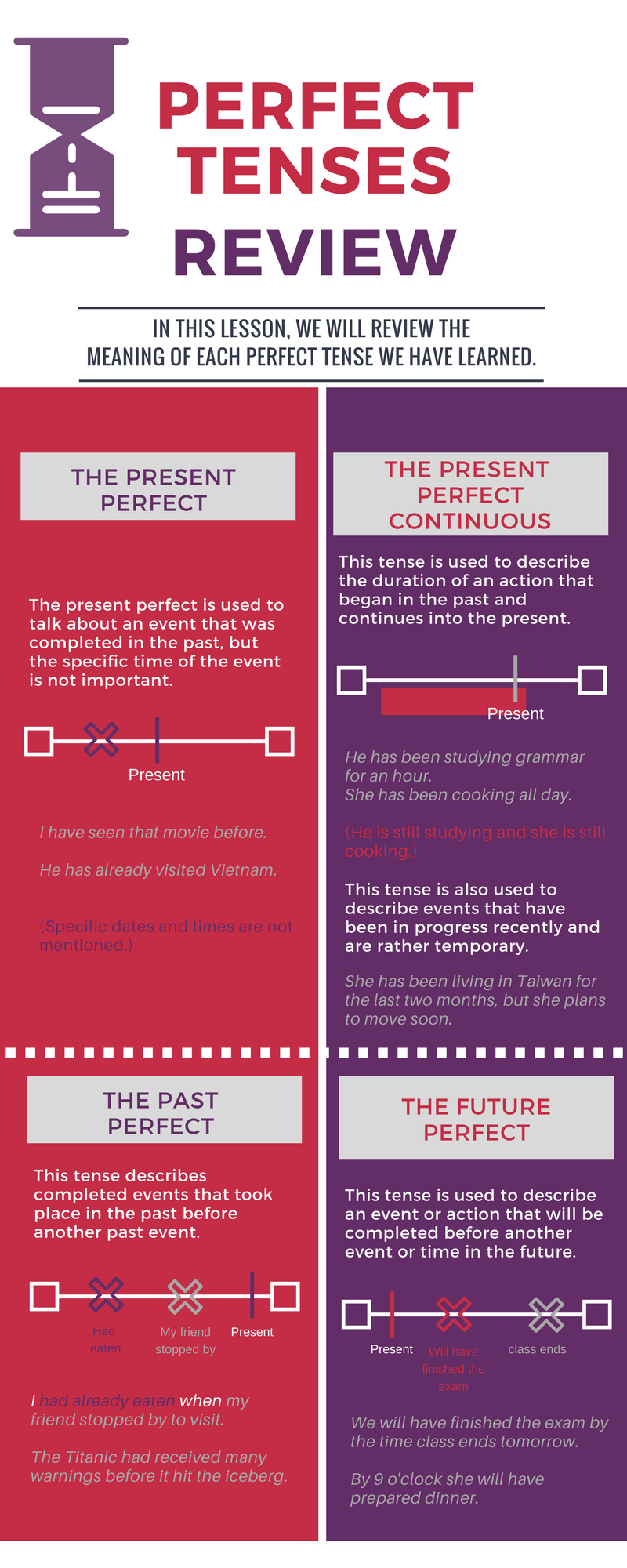
Guess the sentence
Pista: Ella ha ido al cine
Guess the sentence
Pista: Ella habrá hecho la cena a las nueve
Guess the sentence
Pista: Habrán estado filmando la película por un largo tiempo antes de terminarlo.
Guess the sentence
Pista: Susan lo pensó pero decidio que no.
Guess the question
Pista: ¿Qué sabes sobre la situacion en la escuela?
Guess the question
Pista: ¿A donde habia ido antes de ir al centro comercial?
Guess the sentence
Pista: No lo haré aunque sigas insistiendo.
Guess the sentence
Pista: Mi profesor no nos va dejar ir temprano.
